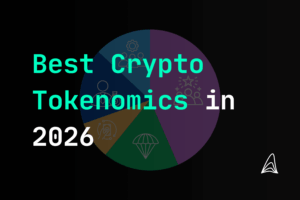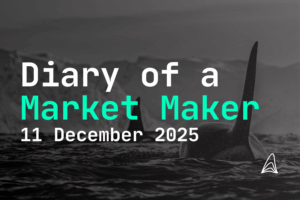
Stablecoin as a Safe Crypto Investment
- Jakob Brezigar
- Last updated: 26.January 2024
- Reading time: 7 min
Imagine a world where your cryptocurrency behaves more like your reliable old teddy bear – always there, always steady – and less like a rollercoaster at an amusement park. Welcome to the realm of stablecoins! A stablecoin is a type of digital currency designed to offer the security of stable value, typically pegged to a fiat currency, making it the ‘comfort food’ of the crypto world.
What are stablecoins? stablecoins have emerged as a significant asset class, offering a unique combination of digital currency flexibility and traditional financial stability. These digital assets, often pegged to stable fiat currencies like the U.S. dollar, serve as a cornerstone in the crypto ecosystem, providing a safe haven against the typical price volatility seen in other cryptocurrencies.

Table of Contents
What is stablecoin use case?
At Orcabay, stablecoins, especially USDT, are primarily used as a transactional tool for international business, particularly with clients in regions where traditional banking is limited. They also serve as margin for trading on perpetual swaps, demonstrating versatility in both finance and trade.
How do stablecoins benefit regions with high inflation?
In countries facing high inflation, like Argentina and Turkey, stablecoins like USDT act as a store of value, offering stability and protection against the local currency’s inflationary pressures.
Are stablecoins used differently in the EU and USA compared to other regions?
Yes, in the EU and USA, where the economy is more stable and currencies like EUR and USD are prevalent, the need for stablecoins as a hedge against inflation is less urgent compared to regions with high inflation and less stable economies.
Key Takeaways
- Stablecoins combine the flexibility of digital currencies with the stability of fiat currencies, mitigating typical cryptocurrency volatility.
- The first stablecoin, BitUSD, laid the foundation for future stablecoins, blending cryptocurrency with traditional financial stability.
- USD Coin (USDC) and DAI are prominent examples of stablecoins, offering reliability and innovative financial solutions in the crypto market.
- Stablecoins are categorized based on their backing, including fiat, commodity, crypto, and reserve-backed, each offering different stability levels and risks.
- Despite their growing popularity, stablecoins face challenges in regulation, highlighting the need for clear guidelines to ensure market stability and integrity.
Is Stablecoin Better Than Bitcoin
In my role as an analyst at Orcabay, I’ve closely observed and engaged with both Bitcoin and stablecoins, gaining a nuanced understanding of their distinct roles in the financial landscape. Bitcoin presents itself as an alternative to the centralized banking system, boasting qualities like being unconfiscatable, a store of value, censorship-resistant, and distributed. Meanwhile, stablecoins like USDT and USDC, most often used by people to store their savings alongside traditional currencies like EUR and USD, represent digital forms of existing central bank money on the blockchain.
While Bitcoin is markedly different than stablecoins, it’s important to recognize that stablecoins, despite their security and stability, face the persistent challenge of inflation, much like traditional currencies. Over extended periods, this inflation can significantly erode the value of savings, akin to ice melting away. In contrast, Bitcoin, with its programmed and predicted limited supply, offers a guarantee that their supply will not get printed away as it is the case with fiat currencies and their digital stablecoin versions.
Fiat Currency
Understanding fiat currency, which is a government-issued currency not backed by a physical commodity but by trust in the issuing authority, is crucial in grasping the concept of stablecoins. Stablecoins, by design, often mirror the value of fiat currencies, thus inheriting their more inherently stable nature compared to traditional digital assets. This stability is pivotal in a market known for its price fluctuations and helps in maintaining price stability.

What is Stablecoin?
A stablecoin is a type of digital money, designed to offer the benefits of a digital asset while maintaining a stable value, typically pegged to a fiat currency like the U.S. dollar. This stability is achieved through various means, including fiat collateralization or algorithmic mechanisms, making stablecoins a reliable form of digital currency in the crypto ecosystem.
The First Stablecoin: BitUSD
The journey of stablecoins in the crypto market began with BitUSD, the first stablecoin, introduced in 2014. It represented a groundbreaking blend of traditional financial principles with the burgeoning field of digital currencies. BitUSD set the foundation for future stablecoins by demonstrating the feasibility of a cryptocurrency maintaining a stable value.
USD Coin (USDC), the Next in Line
USD Coin (USDC) is another notable example in the lineage of stablecoins. Pegged to the U.S. dollar, USDC has gained prominence for its stability and reliability. It exemplifies the potential of digital currencies to offer both the advantages of cryptocurrencies, like decentralization and speed, and the stable value traditionally found in fiat currencies.

Types of Stablecoins
Stablecoins can be classified into various types based on their backing and collateral. The most common types include fiat-backed, commodity-backed, crypto-backed, and reserve-backed stablecoins. Each type has its own unique features and offers different levels of stability, risk, and potential use in the broader crypto ecosystem.
Algorithmic Stablecoins
Algorithmic stablecoins represent an innovative segment in the stablecoin market. They maintain their peg not through tangible assets but via algorithmic mechanisms and smart contracts. These stablecoins automatically adjust their supply based on market dynamics, striving to achieve price stability in a decentralized manner.

Types of Stablecoin Backing
Fiat-Backed Stablecoins
Fiat-backed stablecoins are the most prevalent type, anchored directly to traditional fiat currencies. They provide a high degree of stability and are often favored by regulated financial institutions and individuals seeking a stable digital asset.

Commodity-Backed Stablecoins
Commodity-backed stablecoins are pegged to real-world assets like gold or oil. These stablecoins offer the combined benefits of crypto assets and the tangible value of commodities, appealing to investors looking for assets backing their digital currency.

Crypto-Backed Stablecoins
Crypto-backed stablecoins, pegged to other digital assets, provide an alternative for those seeking exposure to the crypto market while mitigating some of the inherent volatility. These stablecoins, however, carry a higher risk due to the fluctuating nature of the underlying crypto assets.

Reserve-Backed Stablecoins
Reserve-backed stablecoins maintain a reserve of various assets, including fiat currencies, cryptocurrencies, and sometimes commodities. This diversified backing provides a balanced approach, combining the stability of fiat with the growth potential of digital assets.

Stablecoin Benefits
In our operations at Orcabay, stablecoins, particularly USDT, play a crucial role as a means of transaction. This is especially true in our dealings with clients from regions like Asia, due to the limited local banking connections of Slovenian and European banks. Since the Euro is not a feasible option due to lack of global banking integration, we adopt USDT stablecoins and BTC for transactions. This approach not only broadens our client base but also ensures smooth international operations.
Another key use of USDT at Orcabay is as a margin for trading on perpetual swaps, highlighting its versatility beyond just a transactional currency. In countries like those in Asia, Argentina, and Turkey, where high inflation is a concern, USDT serves as a valuable store of value. It offers a more stable alternative to local currencies, which are often subject to significant inflationary pressures.
In contrast, within the EU and the USA, where the Euro and the US Dollar are the main currencies, such issues are less pronounced currently. However, the utility of USDT at Orcabay as a transactional tool and a trading asset underscores the adaptability and the benefits of stablecoins in various economic environments, serving different needs based on regional financial landscapes.
Types of Stablecoin Collateral
Non-Collateralized Stablecoins
Non-collateralized stablecoins, also known as algorithmic stablecoins, rely on complex mechanisms and smart contracts to regulate their value, independent of any physical collateral. This approach to maintaining price stability through algorithms and market forces represents a cutting-edge development in the stablecoin arena.
Fiat-Collateralized Stablecoins
The majority of stablecoins in circulation are fiat-collateralized, backed one-to-one by traditional currencies held in a bank account. This direct backing by fiat currencies like the U.S. dollar provides a high level of stability and trust, making them a popular choice in the stablecoin market.
Protecting Cryptocurrency Traders
The impact of MEV on blockchain ecosystems is multifaceted. While it introduces economic inefficiencies and potential ethical concerns, it also incentivizes the development of solutions like fair sequencing services and decentralized transaction ordering services to mitigate its negative aspects.

Best Stablecoin Issuers
The credibility of stablecoin issuers is a critical factor in the stablecoin market. Reputable issuers are characterized by their adherence to regulatory standards, transparency in reserve assets, and consistent audit practices. These issuers play a pivotal role in maintaining trust in stablecoins, ensuring that each stablecoin token is backed by adequate reserves, be it fiat currency, precious metals, or other assets.
What are the Most Popular Stablecoins?

USDC Stablecoin
The USDC stablecoin, pegged to the U.S. dollar, is a prime example of a fiat-collateralized stablecoin. It exemplifies how stablecoin issuers can create digital assets that combine the benefits of cryptocurrencies with the stable value of fiat currencies. USDC is widely recognized for its reliability and is increasingly used in various financial transactions, including cross-border transfers.
DAI Stablecoin
The DAI stablecoin stands out as a crypto-backed stablecoin, maintaining its peg through a complex system of smart contracts and a collateralized debt position mechanism. This system allows DAI to offer a stable digital currency option within the decentralized finance (DeFi) space, providing an alternative to traditional fiat-backed stablecoins.
Binance USD Stablecoin
Binance USD, a stablecoin issued by one of the world’s largest cryptocurrency exchanges, represents another facet of the stablecoin market. Pegged to the U.S. dollar, it serves as a key component in the Binance ecosystem, facilitating seamless trading and financial operations.
PayPal USD Stablecoin
PayPal’s entry into the stablecoin space with its USD stablecoin is a significant development, signaling the growing integration of stablecoins in mainstream financial services. This move highlights the potential of stablecoins to revolutionize traditional financial systems, offering a digital currency solution that aligns with the stability of fiat currencies.
Disclaimer: The information provided in this article is for informational purposes only and does not constitute financial, investment, or other professional advice. All opinions expressed herein are solely those of the author and do not represent the views or opinions of any entity with which the author may be associated. Investing in financial markets involves risk, including the potential loss of principal. Readers should perform their own research and consult with a licensed financial advisor before making any investment decisions. Past performance is not indicative of future results.

Jakob Brezigar
Jakob, an experienced specialist in the field of cryptocurrency market making, boasts an extensive international presence. With Orcabay, he has skillfully managed major operations and deals for a wide array of global stakeholders.



